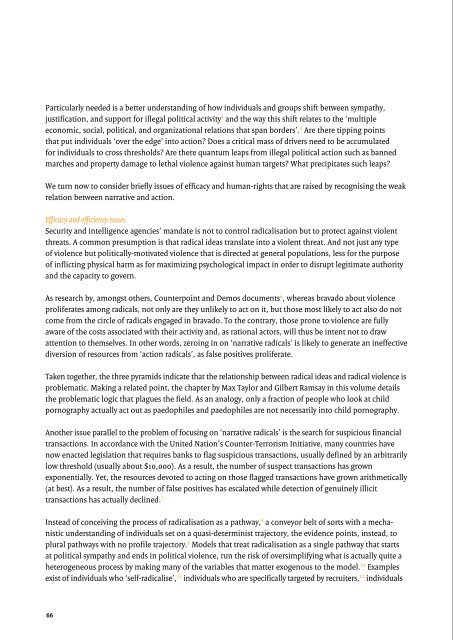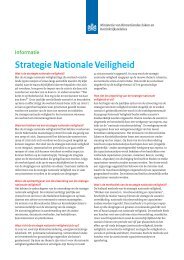Countering Violent Extremist Narratives
Countering Violent Extremist Narratives
Countering Violent Extremist Narratives
- No tags were found...
You also want an ePaper? Increase the reach of your titles
YUMPU automatically turns print PDFs into web optimized ePapers that Google loves.
Particularly needed is a better understanding of how individuals and groups shift between sympathy,justification, and support for illegal political activity 4 and the way this shift relates to the ‘multipleeconomic, social, political, and organizational relations that span borders’. 5 Are there tipping pointsthat put individuals ‘over the edge’ into action? Does a critical mass of drivers need to be accumulatedfor individuals to cross thresholds? Are there quantum leaps from illegal political action such as bannedmarches and property damage to lethal violence against human targets? What precipitates such leaps?We turn now to consider briefly issues of efficacy and human-rights that are raised by recognising the weakrelation between narrative and action.Efficacy and efficiency issuesSecurity and intelligence agencies’ mandate is not to control radicalisation but to protect against violentthreats. A common presumption is that radical ideas translate into a violent threat. And not just any typeof violence but politically-motivated violence that is directed at general populations, less for the purposeof inflicting physical harm as for maximizing psychological impact in order to disrupt legitimate authorityand the capacity to govern.As research by, amongst others, Counterpoint and Demos documents 6 , whereas bravado about violenceproliferates among radicals, not only are they unlikely to act on it, but those most likely to act also do notcome from the circle of radicals engaged in bravado. To the contrary, those prone to violence are fullyaware of the costs associated with their activity and, as rational actors, will thus be intent not to drawattention to themselves. In other words, zeroing in on ‘narrative radicals’ is likely to generate an ineffectivediversion of resources from ‘action radicals’, as false positives proliferate.Taken together, the three pyramids indicate that the relationship between radical ideas and radical violence isproblematic. Making a related point, the chapter by Max Taylor and Gilbert Ramsay in this volume detailsthe problematic logic that plagues the field. As an analogy, only a fraction of people who look at childpornography actually act out as paedophiles and paedophiles are not necessarily into child pornography.Another issue parallel to the problem of focusing on ‘narrative radicals’ is the search for suspicious financialtransactions. In accordance with the United Nation’s Counter-Terrorism Initiative, many countries havenow enacted legislation that requires banks to flag suspicious transactions, usually defined by an arbitrarilylow threshold (usually about $10,000). As a result, the number of suspect transactions has grownexponentially. Yet, the resources devoted to acting on those flagged transactions have grown arithmetically(at best). As a result, the number of false positives has escalated while detection of genuinely illicittransactions has actually declined. 7Instead of conceiving the process of radicalisation as a pathway, 8 a conveyor belt of sorts with a mechanisticunderstanding of individuals set on a quasi-determinist trajectory, the evidence points, instead, toplural pathways with no profile trajectory. 9 Models that treat radicalisation as a single pathway that startsat political sympathy and ends in political violence, run the risk of oversimplifying what is actually quite aheterogeneous process by making many of the variables that matter exogenous to the model. 10 Examplesexist of individuals who ‘self-radicalise’, 11 individuals who are specifically targeted by recruiters, 12 individualsrecruited by family or friendship groups, 13 and more recently individuals who are radicalised throughmedia, largely the Internet. 14Human rights issuesArguments of efficacy aside, there is the human rights perspective to be considered. Democracies have anunfortunate history of labelling any serious challenge to the status quo as radicalism. While the history ofthe rise of the modern security and police state throughout the eighteenth and nineteenth centuries neednot detain us here, 15 states cannot be careful enough when endeavouring to control or censor thoughtand beliefs. Indeed, the rise of democratic pluralism can be read as the struggle against state control andcensorship of views from the margins. Some secularists today would like to attribute many of the world’sills to religion. 16 Their inference is that any type of ‘extremist’ religion ought to be marginalised or banned.The problem with this approach is that it misses the crux of the problem: only actual violence is theresponsibility of security forces.Democracies are premised on the assumption that freedom of speech and thought should prevail, which iswhy free speech is protected from arbitrary government interference. Only under very specific circumstancesis an utterance in and of itself a crime. Rather, the criminal justice system in a democracy is generallystructured to deal with acts of crime ex post facto. Intent and motivation are not normally punishable; theyonly factor into the degree of punishment. In short, gauging threat by means of profiling characteristicssuch as religion, political opinion, or country of origin is not particularly effective, unnecessarily aggravatesthe security problem by alienating entire communities, and is usually difficult to reconcile with democraticconstitutions.Since courts have been reticent to convict based on terrorist motivation and intent, and since politicalopinion does not necessarily translate into actual illegal action, focus on the Global Jihad narrative is not afruitful avenue for intelligence and law enforcement to pursue. Rather the war of ideas that can be trackedin polls, focus groups, web sites and video releases must be separated from the war on terrorists.The pyramid of narrative and the pyramid of action can together contribute to this kind of understandingand this kind of action.Another way to tackle the aim of counter-narratives is to invert the problem. The evidence in this chaptersuggests that one way to think about Global Jihad is as a massive free-rider problem: While the grievancesare widely shared, the call to arms is not. Moreover, those who share the call to arms may have motivesother than grievances to join the fight. For a counter-narrative strategy to be strategic, then, it should (1)frustrate the violent extremists by exacerbating their free-rider problem and (2) capture those individualswho join in the meta-narrative without the meta-narrative having much purchase on their behaviour.The evidence in this chapter suggests that the way to aggravate the free-rider problem is to widen the gapbetween narrative and behaviour. That is best done by (1) raising the costs associated with acting on violentbeliefs (which liberal democracies’ legislators and security forces appear to have done quite successfully inrecent years), and (2) mitigating the mechanisms of radicalisation that can push some individuals to bearsuch costs nonetheless. On both points, the research on counter-narratives overlaps closely with work onopposing terrorist organisations.66 67
















